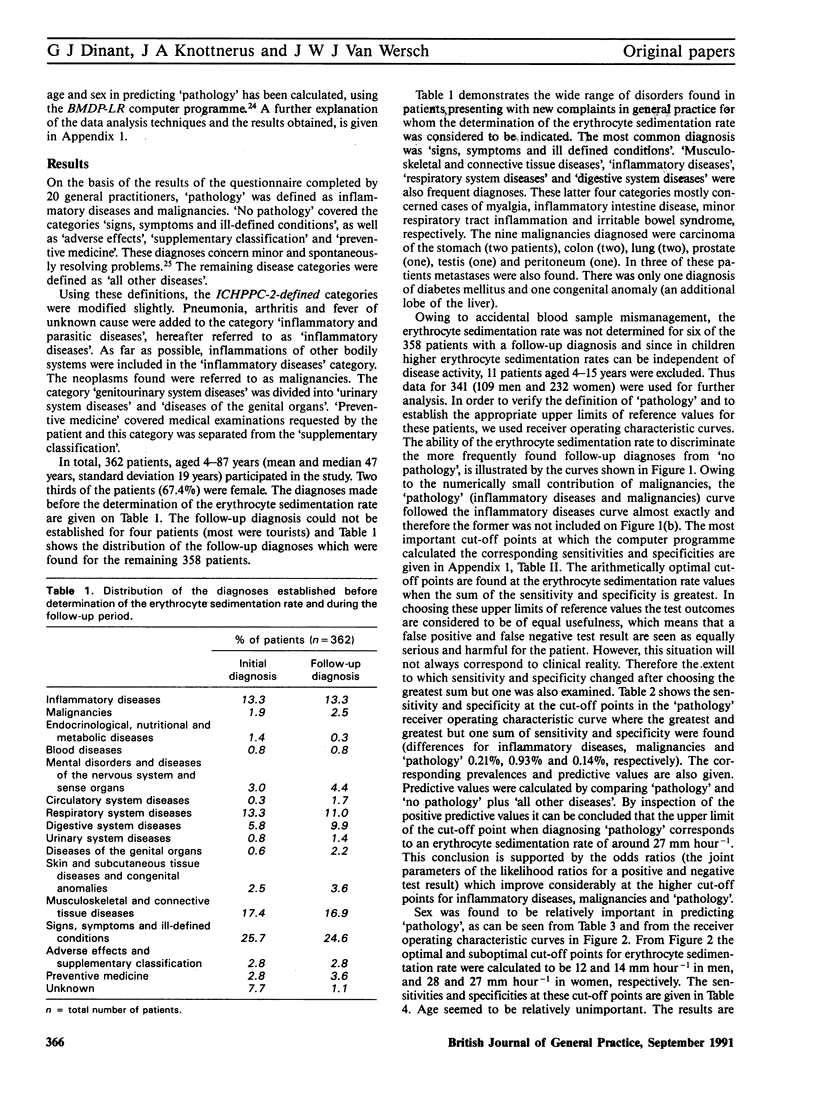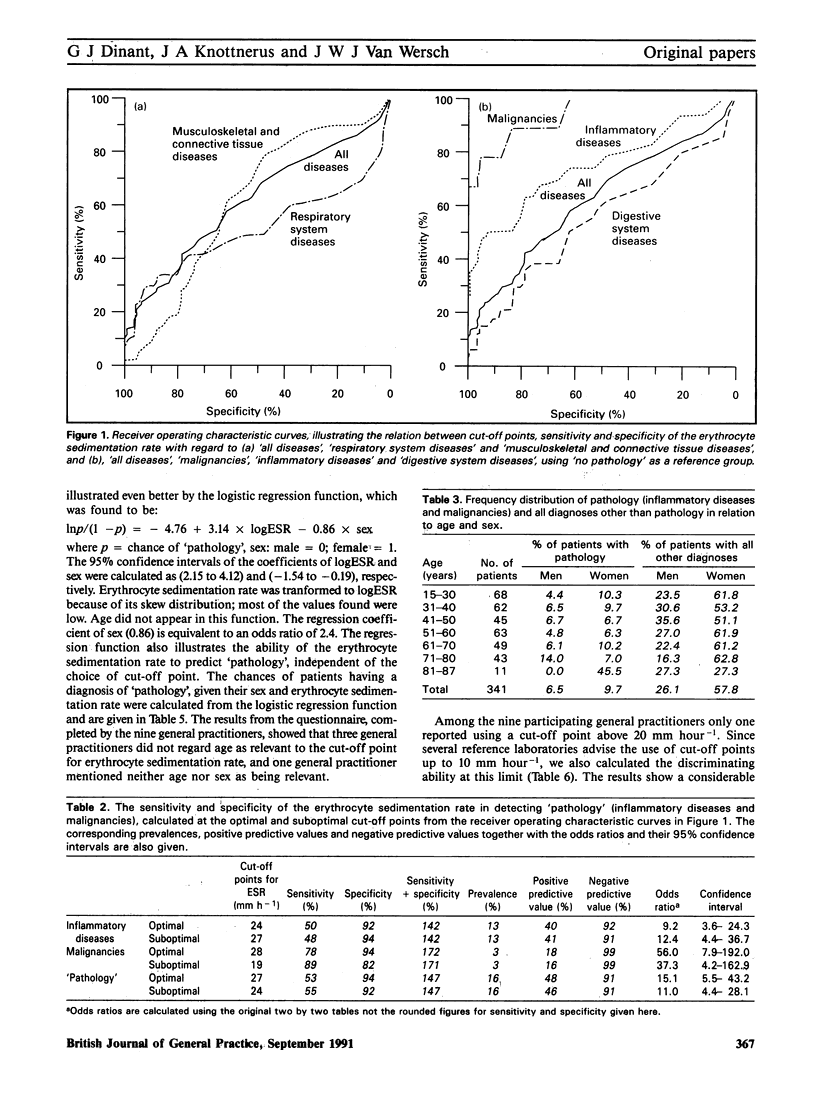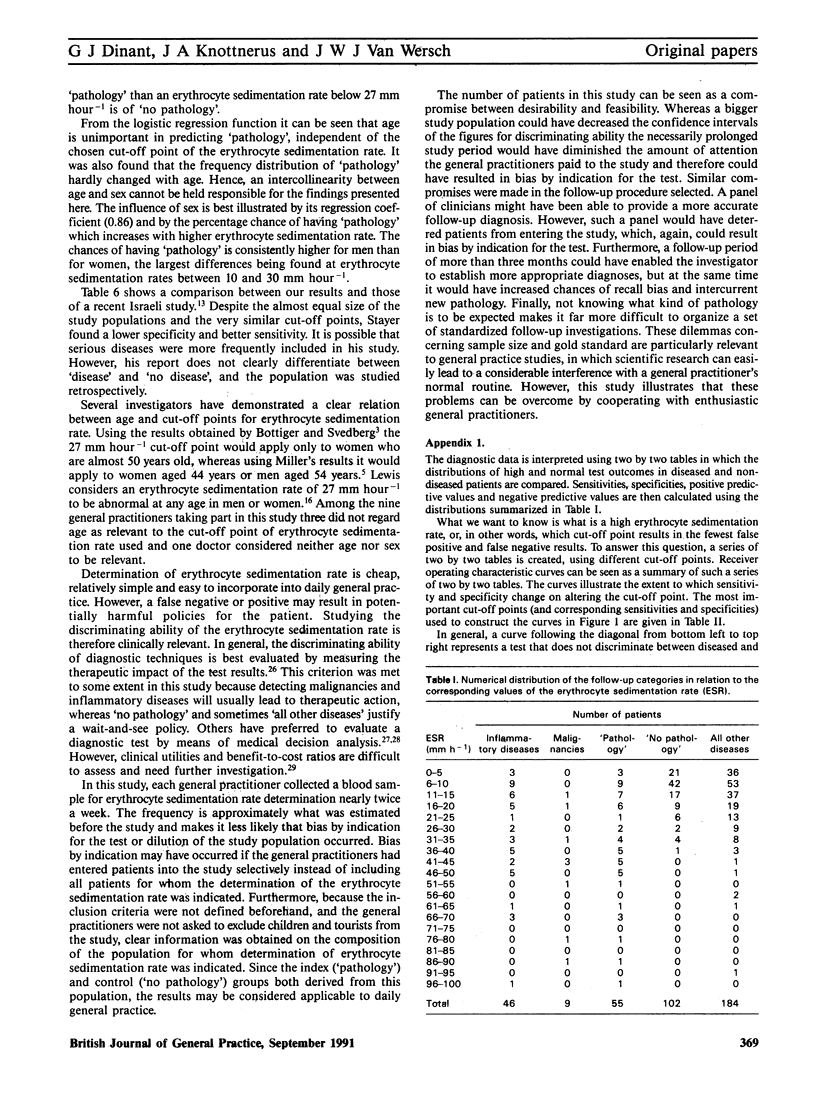Abstract
Despite its frequent use, little is known about the ability of the erythrocyte sedimentation rate to discriminate between 'pathology' (inflammatory diseases and malignancies) and 'no pathology' in general practice. This has been studied by following 362 patients who presented to their general practitioner with a new complaint, for which the general practitioner considered determination of the erythrocyte sedimentation rate to be indicated. The test was performed at the local hospital laboratory and the patients were seen again after three months, in order to establish the follow-up diagnoses. By comparing the test results with the follow-up diagnoses, combined with receiver operating characteristic curves and regression analysis, the erythrocyte sedimentation rate was found to have a reasonable discriminating ability with respect to malignancies and inflammatory diseases (sensitivity 53%, specificity 94%, positive predictive value 48%, negative predictive value 91%, odds ratio 15.1). The upper limit for the normal erythrocyte sedimentation rate should be set at approximately 12 mm hour-1 for men and 28 mm hour-1 for women, and needs no correction for age. It is concluded that the erythrocyte sedimentation rate still deserves a place in the general practitioner's daily routine.
Full text
PDF





Selected References
These references are in PubMed. This may not be the complete list of references from this article.
- Alperovitch A. Controlled assessment of diagnostic techniques: methodological problems. Eff Health Care. 1983 Dec;1(4):187–190. [PubMed] [Google Scholar]
- Boyd N. F., Sutherland H. J., Heasman K. Z., Tritchler D. L., Cummings B. J. Whose utilities for decision analysis? Med Decis Making. 1990 Jan-Mar;10(1):58–67. doi: 10.1177/0272989X9001000109. [DOI] [PubMed] [Google Scholar]
- Böttiger L. E., Svedberg C. A. Normal erythrocyte sedimentation rate and age. Br Med J. 1967 Apr 8;2(5544):85–87. doi: 10.1136/bmj.2.5544.85. [DOI] [PMC free article] [PubMed] [Google Scholar]
- Corberand J., Laharrague P., Fillola G. Blood cell parameters do not change during physiological human ageing. Gerontology. 1987;33(2):72–76. doi: 10.1159/000212856. [DOI] [PubMed] [Google Scholar]
- Crawford J., Eye-Boland M. K., Cohen H. J. Clinical utility of erythrocyte sedimentation rate and plasma protein analysis in the elderly. Am J Med. 1987 Feb;82(2):239–246. doi: 10.1016/0002-9343(87)90063-5. [DOI] [PubMed] [Google Scholar]
- Guyatt G. H., Tugwell P. X., Feeny D. H., Drummond M. F., Haynes R. B. The role of before-after studies of therapeutic impact in the evaluation of diagnostic technologies. J Chronic Dis. 1986;39(4):295–304. doi: 10.1016/0021-9681(86)90051-2. [DOI] [PubMed] [Google Scholar]
- Harkness J. The viscosity of human blood plasma; its measurement in health and disease. Biorheology. 1971 Dec;8(3):171–193. doi: 10.3233/bir-1971-83-408. [DOI] [PubMed] [Google Scholar]
- Hlatky M. A. Evaluation of diagnostic tests. J Chronic Dis. 1986;39(5):357–360. doi: 10.1016/0021-9681(86)90120-7. [DOI] [PubMed] [Google Scholar]
- Kelly M. H., Barber J. H. Use of laboratory services and communication of results to patients in an urban practice: an audit. J R Coll Gen Pract. 1988 Feb;38(307):64–66. [PMC free article] [PubMed] [Google Scholar]
- Kenny M. W., Worthington D. J., Stuart J., Davies A. J., Farr M., Davey P. G., Chughtai M. A. Efficiency of haematological screening tests for detecting disease. Clin Lab Haematol. 1981;3(4):299–305. [PubMed] [Google Scholar]
- Knottnerus J. A., Knipschild P. G., Sturmans F. Symptoms and selection bias: the influence of selection towards specialist care on the relationship between symptoms and diagnoses. Theor Med. 1989 Mar;10(1):67–81. doi: 10.1007/BF00625761. [DOI] [PubMed] [Google Scholar]
- Miller A., Green M., Robinson D. Simple rule for calculating normal erythrocyte sedimentation rate. Br Med J (Clin Res Ed) 1983 Jan 22;286(6361):266–266. doi: 10.1136/bmj.286.6361.266. [DOI] [PMC free article] [PubMed] [Google Scholar]
- Nierenberg A. A., Feinstein A. R. How to evaluate a diagnostic marker test. Lessons from the rise and fall of dexamethasone suppression test. JAMA. 1988 Mar 18;259(11):1699–1702. [PubMed] [Google Scholar]
- Näyhä S. Normal variation in erythrocyte sedimentation rate in males over 50 years old. Scand J Prim Health Care. 1987 Feb;5(1):5–8. doi: 10.3109/02813438709024179. [DOI] [PubMed] [Google Scholar]
- Rafnsson V., Bengtsson C., Lennartsson J., Lindquist O., Noppa H., Tibblin E. Erythrocyte sedimentation rate in a population sample of women with special reference to its clinical and prognostic significance. Acta Med Scand. 1979;206(3):207–214. doi: 10.1111/j.0954-6820.1979.tb13496.x. [DOI] [PubMed] [Google Scholar]
- Ransohoff D. F., Feinstein A. R. Problems of spectrum and bias in evaluating the efficacy of diagnostic tests. N Engl J Med. 1978 Oct 26;299(17):926–930. doi: 10.1056/NEJM197810262991705. [DOI] [PubMed] [Google Scholar]
- Stuart J., Lewis S. M. Monitoring the acute phase response. BMJ. 1988 Nov 5;297(6657):1143–1144. doi: 10.1136/bmj.297.6657.1143. [DOI] [PMC free article] [PubMed] [Google Scholar]
- Zauber N. P., Zauber A. G. Hematologic data of healthy very old people. JAMA. 1987 Apr 24;257(16):2181–2184. [PubMed] [Google Scholar]


